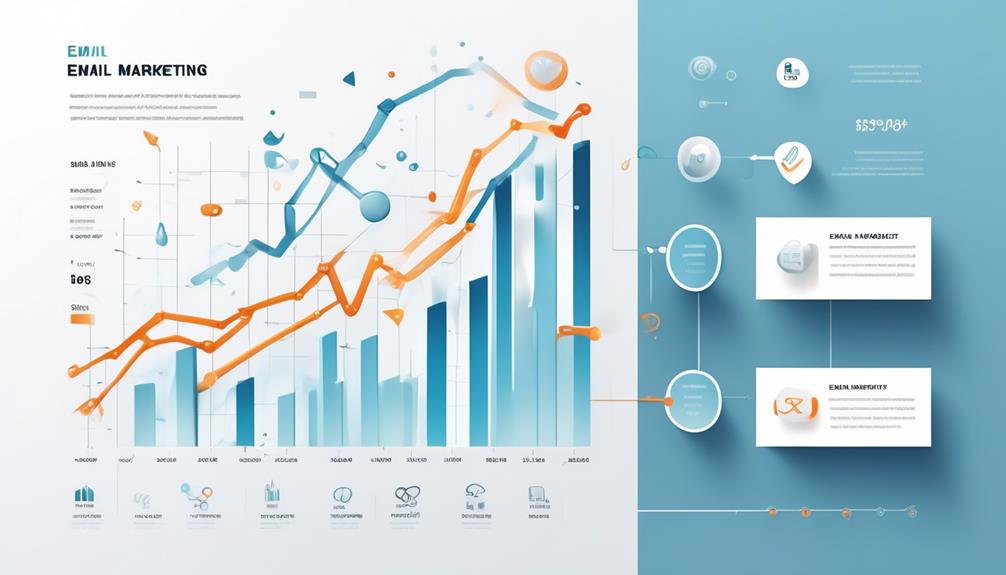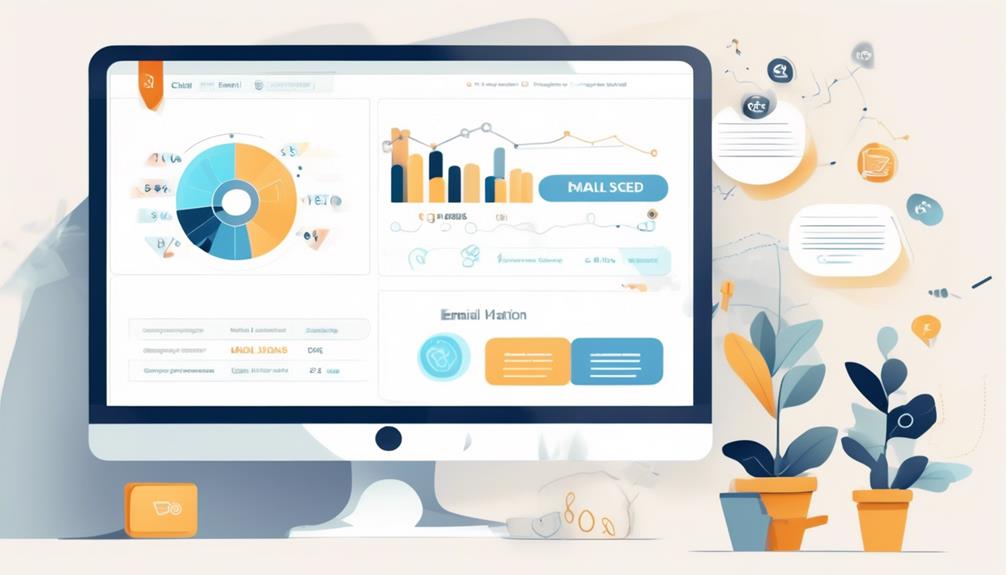As marketers, we often wonder if email marketing is considered a form of paid media. It is important to differentiate between the two in order to allocate resources effectively and understand the extent of our campaign efforts.
However, the answer may not be as straightforward as it seems. While some aspects of email marketing align with paid media, others diverge significantly. Let's explore the nuances and implications of categorizing email marketing as paid media, and consider the strategic implications for our marketing efforts.
Key Takeaways
- Paid media includes TV ads, social media ads, print ads, sponsorships, and more, and email marketing can be classified as paid media due to paying for services and sponsored content placement.
- Email marketing offers a cost-effective way to engage with the audience directly, allowing for personalized communication and precise targeting.
- Email marketing fosters personalized client relationships and sustains engagement with potential clients beyond paid media limitations.
- Email marketing plays a crucial role in acquisition by nurturing relationships, providing a direct line of communication with prospects, and ensuring consistency between paid social media and email marketing for a seamless customer journey.
Definition of Paid Media
In the realm of marketing, paid media encompasses content created by a brand and distributed to an audience developed by a third party. This includes TV ads, social media ads, print ads, sponsorships, and more. It involves a strategic approach where the brand pays to leverage the reach and engagement of established platforms or channels. This makes it a crucial component of a brand's overall marketing mix, enabling targeted exposure to specific demographics or interest groups.
While some may argue that email marketing falls under owned media due to the direct control a brand has over its email list and content, it can also be classified as paid media. Email marketing often involves paying for services to manage and distribute email campaigns. In some cases, brands pay for sponsored content placement in third-party newsletters. Therefore, email marketing blurs the lines between owned and paid media, showcasing the dynamic nature of marketing channels and the need for a comprehensive understanding of their classifications.
Understanding the nuances of paid media is essential for brands aiming to optimize their marketing strategies and reach their target audiences effectively.
Characteristics of Email Marketing

Email marketing offers a cost-effective way to engage with our audience directly, allowing for personalized communication.
This method enables us to precisely target and segment our audience, providing detailed analytics for strategic decision-making.
Cost-Effective Marketing Method
When considering cost-effective marketing methods, email marketing stands out as a budget-friendly option for businesses of all sizes. Here's why:
- Targeted Audience: Email marketing allows businesses to reach specific demographics, ensuring that marketing efforts are focused on engaging the most relevant audience.
- Personalized Content: With email marketing, businesses can tailor messages to individual recipients, increasing the likelihood of engagement and conversion.
- Detailed Analytics: Email marketing provides comprehensive analytics, enabling businesses to measure the effectiveness of their campaigns and make data-driven decisions for optimization.
- High ROI: It offers a significant return on investment, making it a valuable tool for businesses aiming to achieve their marketing goals without substantial financial investment.
Email marketing proves to be a cost-effective marketing method that delivers tangible results.
Direct Communication Channel
Utilizing a direct communication channel, email marketing fosters personalized client relationships and sustains engagement with potential clients beyond the limitations of paid media. It provides a platform to continue the conversation with potential clients, picking up where paid media leaves off.
This direct line of communication nurtures individuals and establishes long-term relationships, making it a crucial aspect of direct marketing. Tailoring information based on the customer journey and maintaining message match are essential characteristics of email marketing.
Furthermore, constant optimization and testing are recommended, including adjustments to budget, audience segments, and calls to action. These strategies ensure that email marketing remains an effective and personalized direct communication channel, maximizing engagement and fostering strong client relationships.
Targeted Audience Engagement
Transitioning from direct communication to targeted audience engagement, the characteristics of email marketing allow for personalized and effective client interactions beyond the scope of traditional paid media strategies.
- Tailored Messaging: Email marketing enables the delivery of customized content, catering to the specific needs and interests of individual recipients.
- Long-term Relationship Building: It establishes direct lines of communication with clients, fostering lasting connections and brand loyalty.
- Integration with Paid Media: Consistency in message match is crucial for combining email marketing with paid media strategies, ensuring a cohesive and impactful approach.
- Optimization and Testing: Tinkering with various elements such as budget, audience segments, and calls to action is recommended to enhance the effectiveness of email marketing and paid media strategies.
Advantages of Paid Media

An effective paid media strategy can drive new traffic to your website and create brand awareness, while email marketing can establish lasting client relationships and nurture users into the brand.
The advantages of paid media lie in its ability to reach a wide audience and introduce them to your brand and offerings. With paid media, you can target specific audiences effectively, ensuring that your message reaches the right people at the right time. Additionally, paid media offers instant results and easy tracking, allowing you to adapt your approach in real-time.
Integrating paid media with email marketing provides a seamless customer journey, offering consistent messaging and tailored information based on the customer's interactions with your brand. This integration enables you to engage with your target audience through multiple touchpoints, reinforcing your brand's presence and increasing the likelihood of conversion.
Leveraging influencers to introduce the brand and drive newsletter signups is a powerful strategy that combines the strengths of paid media and email marketing, ultimately maximizing your reach and impact.
Role of Email Marketing in Acquisition

Email marketing significantly contributes to the acquisition process by establishing personalized client relationships and providing a direct communication line to individuals. Here's how it plays a crucial role in acquisition:
- Nurturing Relationships: Email marketing complements paid social media by nurturing on-site traffic, fostering brand familiarity, and guiding potential customers through the acquisition funnel.
- Direct Communication: It provides a direct line of communication with prospects, allowing for personalized interactions and tailored messaging to drive acquisition efforts.
- Consistent Message Match: Maintaining consistency between paid social media and email marketing ensures a seamless customer journey, enhancing the effectiveness of acquisition strategies.
- Optimization and Testing: Both paid social media and email marketing require continuous optimization and testing to refine audience segments, budget allocation, and calls to action, maximizing acquisition outcomes.
Disadvantages of Paid Media

Paid media can incur high costs, especially as competition increases, potentially leading to a reliance on non-scalable channels.
Additionally, limited organic reach can hinder the effectiveness of paid media efforts, making it challenging to reach a wider audience without additional investment.
These factors highlight the potential drawbacks of relying solely on paid media for marketing purposes.
Cost of Advertising
Given the significant investment required, paid advertising may not always yield cost-effective results for all businesses. When considering the cost of advertising, it's important to note that the impact of many types of advertising has been degraded due to ad blocking and banner blindness.
Additionally, inconsistent marketing materials can confuse users and lead to abandonment, affecting the effectiveness of paid media.
Moreover, paid media is essentially any kind of advertising, but it can get more expensive as competition increases. Therefore, adapting and testing different budget, audience segments, and calls to action in paid media is recommended to find the optimal strategy.
As businesses evaluate the cost of advertising, these factors should be carefully considered to ensure that the investment in paid media, including email marketing, aligns with the desired outcomes.
Limited Organic Reach
Limited organic reach presents a significant challenge for businesses using paid media, as it may hinder the effective targeting of potential clients who aren't directly reached by paid advertising efforts.
In the context of email marketing, limited organic reach means that promotional emails may not reach a wide audience without additional investment in paid promotional efforts. This can impact the overall effectiveness of email marketing campaigns, as reaching a larger audience often correlates with higher engagement and conversion rates.
With the decline of organic reach on various platforms, including social media, businesses relying solely on organic methods may struggle to reach their target audience effectively.
Therefore, understanding the limitations of organic reach underscores the importance of integrating paid media strategies to complement email marketing efforts and achieve broader audience reach.
Email Marketing ROI

Measuring email marketing ROI involves analyzing the cost of tools, personnel, and content creation against the revenue generated from email-driven sales and conversions.
To effectively evaluate the return on investment of email marketing efforts, we consider several key factors:
- Cost per acquisition: Calculating the cost incurred for acquiring a customer through email marketing initiatives.
- Revenue generated per email sent: Determining the average revenue generated for each email sent in a campaign.
- Overall return on investment: Assessing the overall profitability and effectiveness of email marketing activities.
Integration of Email Marketing With Paid Media

Integrating email marketing with paid media creates a powerful synergy that drives brand awareness, nurtures personalized client relationships, and maximizes conversion opportunities across multiple touchpoints. Paid social media introduces potential clients to the brand and its offerings, while email marketing collects on-site traffic and nurtures users into the brand, making them a powerful combination. This integration is essential as paid social media drives new traffic to the website, establishing brand awareness, while email marketing nurtures personalized client relationships and provides a direct communication line to individuals.
Consistency in marketing materials is vital for integrating paid social media and email marketing campaigns. Tinkering with budget, audience segments, and calls to action can optimize and test the integration, identifying where conversions are happening with different audience segments. It involves using similar copy and assets in paid ads and emails for message match consistency and increasing social media engagement through reminders about the brand's social media activities. Utilizing influencers to introduce the brand and drive newsletter signups is also part of the integration process.
Email Marketing as a Promotional Tool

Email marketing serves as a powerful promotional tool, nurturing users into the brand and complementing the top-of-funnel engagement of paid social media.
When considering email marketing as a promotional tool, several key factors come into play:
- Establishing Long-Term Relationships: Email marketing provides a direct line of communication to individuals, fostering personalized client relationships over time.
- Consistency and Targeting: Ensuring consistency in marketing materials and targeting based on the customer journey is crucial for effectively combining paid social media and email marketing campaigns.
- Optimization and Testing: Regular optimization and testing, such as adjusting budget, audience segments, and calls to action, are essential for identifying the optimal strategy for utilizing email marketing as a promotional tool.
- Integration with Paid Social Media: Integrating paid social media and email marketing involves using similar copy and assets, leveraging influencers to drive newsletter signups, and maximizing the impact of promotional activities.
Paid Media Strategies for Email Marketing

To maximize the impact of email marketing, implementing paid media strategies is essential for driving new traffic and expanding brand reach. Paid media, such as social media ads and sponsorships, plays a critical role in introducing potential clients to the brand, complementing email marketing efforts.
Consistency in message match is crucial for combining paid social media and email marketing campaigns, ensuring a seamless user experience and preventing confusion. Optimizing and testing paid social media and email marketing strategies by adjusting budget, audience segments, and calls to action can help identify the most effective approach for client acquisition.
Integrating paid social media and email marketing involves using similar copy and assets for message match consistency, leveraging social media engagement, retargeting ads, and influencer partnerships to drive newsletter signups. The POGLE media model, introduced in the book 'Email Marketing Rules', provides a framework for understanding different channel activities, offering clarity in crafting a comprehensive marketing mix for client acquisition.
Paid media strategies are an integral part of a successful digital marketing approach, enhancing the effectiveness of email marketing efforts.
Email Marketing in the Marketing Mix

Let's now explore the impact of email marketing on the overall marketing mix.
We'll delve into the effectiveness of email marketing and its return on investment (ROI).
Understanding how email marketing fits into the broader marketing strategy is crucial for maximizing its potential.
Email Marketing Effectiveness
When evaluating the effectiveness of email marketing in the marketing mix, we find that it seamlessly picks up where paid media leaves off, playing a crucial role in nurturing on-site traffic and fostering long-term relationships with individual clients.
- Email marketing seamlessly continues the conversation with potential customers who've interacted with paid media, guiding them towards conversion.
- It allows for personalized communication, building trust and loyalty with the audience through tailored content and offers.
- Message consistency between paid social and email marketing ensures a cohesive brand experience, reducing user confusion and potential abandonment.
- Continuous testing and optimization of email marketing strategies, including budget allocation and audience segmentation, is crucial for maximizing its effectiveness.
Email Marketing ROI
Email marketing significantly contributes to the overall return on investment within the marketing mix, bolstering customer engagement and nurturing long-term relationships through personalized communication and targeted strategies.
| Email Marketing ROI | Facts | Importance |
|---|---|---|
| Complements paid social | Nurtures on-site traffic | Bolsters customer engagement |
| Integration with paid | Message match consistency | Fosters long-term relationships |
| Optimization and testing | Identify optimal strategy | Contributes to overall marketing success |
| Effective integration | Utilize similar copy | Enhances marketing mix effectiveness |
This data-driven approach highlights the importance of email marketing in enhancing ROI within the marketing mix, emphasizing its role in nurturing customer relationships and optimizing marketing strategies.
Does Using Paid Media Improve the Success of Email Marketing Campaigns?
Using paid media can significantly boost email marketing effectiveness. By targeting specific audiences through paid platforms, the reach and visibility of email campaigns can increase. This can lead to higher open and click-through rates, ultimately improving the overall success of email marketing effectiveness.
Frequently Asked Questions
Is Email Marketing Paid or Owned Media?
Email marketing is a powerful tool in our arsenal. It falls under owned media, giving us complete control over content and audience. Unlike paid media, it doesn't require payment for distribution, making it a cost-effective way to engage our audience.
With email marketing, we can tailor content and reach our audience directly, enhancing brand loyalty and driving conversions. It's a valuable owned media channel that we leverage to its full potential.
What Type of Media Is Email Marketing?
Email marketing is a type of owned media, involving content created and distributed by the brand to its developed audience. It's cost-effective and allows for targeted, personalized content, making it advantageous for client acquisition and nurturing.
Our mastery of this crucial marketing tool enables us to establish long-term, personalized client relationships. This makes email marketing an essential form of marketing communication, distinct from leased media activities like social marketing and mobile apps.
Is Email Marketing Paid or Organic?
Email marketing is considered organic rather than paid media. It involves reaching out to interested audience members through direct messages, fostering personalized communication. This strategy offers targeted content, action-oriented results, and detailed analytics.
Integrating email marketing with paid media strategies can be beneficial, nurturing relationships with existing customers and increasing social media engagement.
Email marketing's cost-effectiveness and ability to reach a large audience make it a valuable part of the marketing mix.
What Is Considered Paid Media in Marketing?
In marketing, paid media encompasses activities where the brand pays to create and distribute content to an audience developed by a third party, such as TV ads, print ads, social media ads, and sponsorships. This approach allows us to reach an audience we didn't cultivate ourselves, but it's vital to consider potential challenges like ad blocking and banner blindness.
It's essential to integrate paid media with email marketing for maximum impact and engagement.
Conclusion
In conclusion, email marketing isn't considered paid media, but it plays a crucial role in the marketing mix.
Like a skilled craftsman shaping a delicate piece of pottery, email marketing allows for targeted and personalized content delivery, making it a powerful tool for acquisition and promotion.
When integrated with paid media strategies, it becomes even more effective in reaching and engaging the audience.
Email marketing remains a cost-effective and impactful component of any marketing campaign.










